ATON: Frequently asked questions

Is the ATON(+) set compatible with a smart meter or power inverter?
Our ATON system is a set consisting of an energy meter (CAN-EZ3A) and a controllable immersion heater (EHS-R). The energy meter measures if and how much excess energy is available and controls the immersion heater based on this. For operation, ATON does not require a connection to a power inverter or smart meter.
What’s the difference between ATON and ATON+?
The set ATON comes with the energy meter CAN-EZ3A and the set ATON+ comes with the energy meter CAN-EZ3. The meter CAN-EZ3 additionally has a Modbus RTU interface, an S0 pulse output and four sensor inputs.
Can the energy meter control other (third party) immersion heaters?
The energy meter is a part of our x2 series of freely programmable devices. Therefore, the device can be expanded upon with several components and freely programmed. Through specific programming, nearly any circumstance can be accommodated. Our power controllers (LST3x13-DL and LST6x13-DL) can (de-)activate foreign immersion heaters in simple use cases. Programming must be adjusted to accommodate this.
Can I operate my battery storage or wall box with ATON(+)?
The general question here is: how or by which device is the battery storage/wall box controlled in the first place? This is usually either done by the power inverter or a specific controller. If the latter is the case, the following problem arises: the presence of a second controller referring to the same control variable. This can cause the two controllers to simply operate against one another. If our devices should control the components, the required kinds of signals/interfaces come into question. The CAN-EZ3(A) is a part of our x2 series of freely programmable devices. Therefore, this device can be freely programmed and expanded upon using all sorts of components. Through specific programming, nearly and any circumstance can be accommodated. Since every system is entirely unique, we can’t offer concrete programming examples. The settlement of the control strategy and appropriate programming are a job for a suitable tradesman.
Is there an app to access the energy meter?
With the additional installation of the Control and Monitoring Interface “C.M.I.”, it’s possible to access the system using a smartphone application or a web browser.
Can the energy meter and immersion heater be connected without using wireless transmission?
The energy meter can also communicate with the immersion heater using wired connection (CORA-DL).
Can the immersion heater be operated without an energy meter?
Our immersion heater can be operated using CORA-DL, CORA wireless or a PWM signal.
Can the immersion heater be operated by a power inverter or other foreign device?
Our immersion heater can be operated using a PWM signal. 10-90% correlate to 0-3000W power, however operation only begins at min. 40 W (equals roughly 12% PWM). Whether the power inverter or other devices can output such a signal must be inquired about at the producer of the specific device.
Am I, as a private end-consumer, allowed to install the energy meter and immersion meter myself?
The opening, connection and commissioning of the device may only be carried out by fully qualified personnel. While doing so, they must observe all local safety requirements. Detailed safety requirements can be found in the manual. We explicitly advise that private end-consumers do not carry out the installation or commissioning themselves.
Can the immersion heater be installed in a DHW cylinder?
[Update, July 28, 2022]: We expressly advise against using our heating elements in drinking water storage tanks.
The immersion heater is meant for installation in buffer tanks, in which the same heating water circulates. Due to galvanic reactivity, the immersion heaters are not suitable for installation in DHW cylinders. Install in such cylinders at own risk. This requires specific, standardized measures and frequent inspection (e.g., of the sacrificial anode). We do not offer any guarantee or warranty in case of calcification and galvanic corrosion!
Is lime precipitation in domestic water problematic for the immersion heater?
When heating DHW, there is always a risk that limescale deposits will form, for example on the surfaces of immersion heaters. Whether DHW is prone to cause scaling depends on various water parameters, including water hardness.
These are physical principles which must be taken into consideration by the technician when installing components that will come into contact with DHW. If, in the relevant system, the water is prone to cause scaling due to the hardness, measures must be taken to ensure post-treatment of the DHW. It is essential to regularly take the immersion heater out of the cylinder and remove any limescale deposits. Alternatively, for example, a softening system can be used for post-treatment of the water.
See also for functionality of the immersion heater
Blog post: "Your choice of immersion heater matters"
